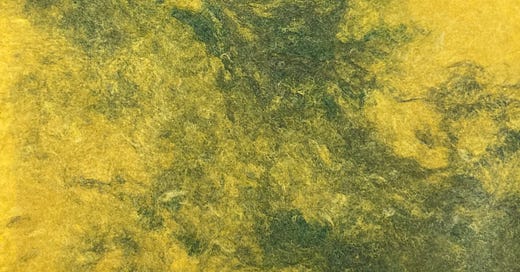Let us begin with an incantation:
May the gods of uncertainty unmake us into unfamiliar shapes, so that we may dance our way into new thoughts, new creative possibilities and ways of being.

What feeling does the word uncertainty stir in you? Listen close. Feel into it. What do you notice? Uncertainty is one of the most essential elements of art making. Imagination gets a lot of credit as a capacity emblematic of the enlightened mind of Man, with its accompanying iconography of light bulbs and rainbows illuminating Man’s exceptionalism and ascent from darkness. Imagination is active, engaged in associating and arranging. It wills and directs. It names new relations. Uncertainty is where things break down, bubble up, leak, ooze — it is the slime of decomposition, deformed, unformed, and unnameable, the dark terrain that merges and mystifies the progress of beginnings and endings.
In all of my workshops and courses, I use the naming convention Drawing on. Drawing on the Senses, Drawing on the Body, Drawing on Plants etc. The on leaves room for uncertainty, for aliveness. When we make art with certainty, we make dead things. We make pinned butterflies, preserved specimens of a world of known behaviors and listable qualities. Drawing Plants names “plants” as a known territory, colonized, mapped and pinned. Approaching a subject, set of ideas, or project with certainty violently limits the possibilities for creative emergence, of becoming-with a creative process.
William Kentridge, in his talk at the Brooklyn Public Library in December 2018, explained the gesture animating the name of his cross disciplinary art space, “The Center for the Less Good Idea”:
The name of the Centre comes from a Tswana proverb: "If the good doctor can't cure you, find the less good doctor." It is a strategy for making performances and art, but it also has to do with a belief that the grand ideas, the grand certainties are always accompanied by violence and authoritarianism. Every large idea has let us down and is accompanied by invading armies. Our only hope is to try to find ideas at the margins, small provisional ways of working--and in this way, make our way through the morass of the contemporary world.
Drawing on uncertainty is the practice of learning to work with unfixed outcomes. This is a practice of finding the strength in staying open, of letting ourselves be guided by intuition, by discomfort, by weedy ideas growing through the cracks of our mapped and paved worlds. The rightness we discover through this practice may be the trading of comfort for the quickened pulse of finding ourselves at an edge and daring to fall.
We often resist uncertainty in our work because it isn't a process we can do. We can't to uncertain. Uncertainty is something we have to give ourselves to. We have to be uncertain, and this means being unmade, becoming unknown to ourselves. Who are your gods of uncertainty? What moves you to dance over the edge, to press yourself against unexpected darkness and shake your hips, bend and sway?
I invite you, in your creative explorations, to fall apart. To break down. To not know how it all comes together. You are a wild world of becomings, interwoven into a world that is making meaning out of you. And for those of you looking for more guided undoing, you can access this week’s exercise on the Drawing on the Senses page.



